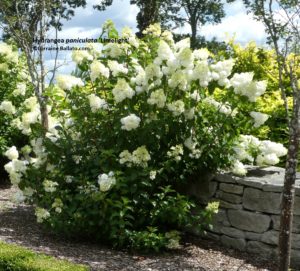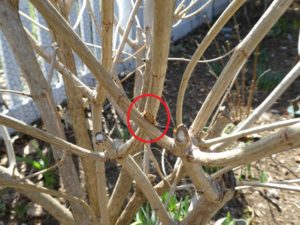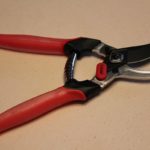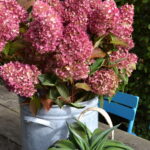My apologies for being absent for so long. I have been working on a new hydrangea book about pruning to the exclusion of just about everything else. But I am seeing lots of questions in a variety of formats asking about hydrangea pruning. Clearly, it’s time to open the hydrangea pruning discussion for 2021.
If you live in the northern hemisphere, the only hydrangeas you should even think about pruning now are the ones that bloom only on new wood. That means hydrangeas whose flowers this year will come from the stems they grow this year. Period. Exactly which ones are they?
New Wood Panicle Hydrangeas

Hydrangea paniculata flowers emerging white
Panicle hydrangeas (paniculata) are the ones that bloom on new wood all the time. By name, panicle hydrangeas could be ‘Limelight,’ Pinky Winky, Strawberry Sundae, etc. In short, they are hydrangeas that love the sun. Their flowers are cone- or football-shaped and can be white, green, and shades of pink (never blue), especially as they age. Some can be as small as 18” tall while others can be gigantic 8 footers.
New Wood Smooth Hydrangeas

Hydrangea Arborescens flowers ageing to light pink
The other new wood hydrangeas (arborescens) are woodland/smooth hydrangeas. They might be called ‘Annabelle,’ Incrediball, Haas’ Halo, etc. They also bloom on this year’s growth and can be found in semi-shaded and/or sunny sites. Their flowers are distinctively big round puffs of either green, white, or shades of pink (never blue).
How Do You Cut A Panicle Hydrangea Back
First, you can remove any stems that are dead, diseased, or damaged. Also look for stems that are growing inward or crossing/rubbing against other stems. Unmanaged, that will leave you with a damaged stem that can be a gateway for insect and disease later on.

Crossing hydrangea stems bruise your plant
After that, you can simply deadhead your plant and let the rest go. But if you need to control growth to some extent, then the plant can be taken down by about one third, generally speaking. Unless you have a new plant that is barely 2 feet tall. Then the thing to do is just take off the tip, including any spent flowers.
But here’s my caution to you. If you live in a cold climate, leave the plant alone. There’s still a lot of winter left and you want to allow for winter kill. Wait a few more weeks. Gardeners in zones 7 and warmer could take a chance and start now. Just remember there is always the possibility of late winter cold snaps which could knock your plants back.
How Do You Cut A Woodland Hydrangea Back
Just as with the any plant, start by removing the dead, diseased, and damaged wood. Do the same “opening up” task described for panicle hydrangeas and remove crossing and inward growing branches. You may even want to take out several stems at the ground level to reduce the overall size of your plant. My preference, however, is to dig out those ground level stems and start new plants somewhere else or give them away. They transplant wonderfully as long as you capture a good handful of roots.
DO NOT CUT YOUR WOODLAND HYDRANGEAS DOWN TO THE GROUND. When you do that, you encourage new stems that will not be strong enough to hold their later season flowers. Instead, leave several stems up at about 30 inches to help form a supportive framework for your plant.
What About Big Leaf Hydrangeas (macrophylla) and Mountain Hydrangeas (serrata)?
Your big leaf hydrangeas flower on old wood. Some can produce flowers on new wood (e.g., ‘Endless Summer’) as well. If you know for certain that your plant flowers only on old wood (e.g., ‘Nikko Blue,’ Cityline, etc.), you could take care of the dead, diseased, and damaged stems. You could also go after the old wood that won’t give you flowers. But as mentioned earlier, I would leave them alone for now. Again, you want to let ol’ man winter do his thing before you work on them.
Pruning advice for mountain hydrangeas (serrata) is the same as above for big leaf.
The other hydrangeas you may have like oak leaf (quercifolia) and climbing (petiolaris) flower only on old wood. Follow the same advice as above for big leaf and mountain hydrangeas for now.
For a more detailed discussion on hydrangea pruning, go HERE to a post I wrote last March. Ignore the last section on “Upcoming Talks,” some of which got cancelled because of Covid.
COMING ATTRACTIONS
This is a new year and I am part of the Zoom Boom, i.e., all my talks can be delivered virtually. Bookings are brisk as audiences have become well accustomed to this new world of ours. If you are interested, just click HERE and you will be taken to the “Contact Me” page of my site to begin our dialogue.

Audience and speaker in the good old days of in-person talks!
I’ll be back in a short time to tell you about the new hydrangeas that will be available this year. In a word, they are fabulous (but I love them all)! In the meantime, enjoy the rest of this “quiet season.”
6 Secrets for Stunning Hydrangea Flowers
Get my FREE mini-guide with 6 fool-proof tips showing how to grow hydrangeas that produce the most amazing flowers.
No spam - I promise!




